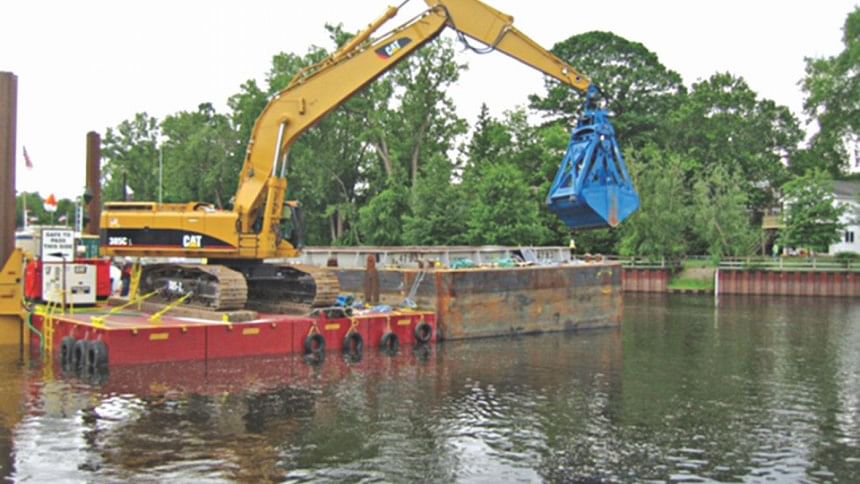Adverse effects of river dredging on the aquatic ecosystem

In response to UNESCO's concerns over dredging rivers near the Sundarbans in order to facilitate transportation of coal to the Rampal Power Plant, an influential member of the ruling party remarked: "It's not clear to me how rivers will get destroyed if dredging takes place there."
Of course dredging never destroys a river. Dredging is a necessary activity that is required to increase the depth of rivers and remove the unwanted deposits for safe passage of boats and ships. But by its very nature, the act of dredging will change the environment. Because of this, experts and green activists in Bangladesh and around the world are concerned about the geomorphic effects of dredging rivers flowing through the Sundarbans, a UNESCO World Heritage site.
The exact ramifications of river dredging upon the aquatic environment will depend on topology, sediment characteristics, the dredging technique employed, existing floodplain connectivity and antecedent environmental conditions. So, the effects discussed in this article are generic.
Dredging activities potentially affect not only the site itself, but also surrounding areas, through a large number of impact factors, such as turbidity, sedimentation, resuspension and release of contaminants. Effects can be immediate or develop over a longer time frame and they may be temporary or permanent.
The impacts of river dredging on the aquatic ecosystem and the life it supports have been relatively well-studied. The impacts are generally two-fold – firstly as a result of the dredging process itself and secondly as a result of the disposal of the dredged material. During the dredging process effects may arise due to the excavation of sediments at the bed, loss of material during transport to the surface, overflow from the dredger while loading and loss of material from the dredger and/or pipelines during transport.
Dredging will affect a river's composition, diversity and resiliency in a variety of ways. After a river is dredged, its banks will become prone to erosion. Eroded banks will stimulate further build-up of silt, exacerbating rather than improving problems with navigation. Moreover, disturbance of bank vegetation caused by erosion will remove cover and shade. This will increase light penetration and hence water temperature, which will cause fish to migrate. Besides, loss of soils will disturb the habitat of river bank fauna.
River dredging can have a number of impacts on local fish populations. Many fish species depend on structured habitats for refuge from the current. The loss of natural habitat can render new dredged habitats unsuitable for shallow-water fish. Furthermore, deeper habitats may make a river more vulnerable to exploitation by invasive non-native species.
Fish eggs, fry, larvae and juveniles can be sucked up and displaced by dredging, which will cause death. If they do survive, they will experience higher mortality rates due to injuries, physiological stressors, disorientation, abrasions and infections. Molluscs and amphibians which are important parts of the aquatic ecology can also suffer death from dredging equipment.
Dredging has significant impacts on fish and amphibians during reproduction. Spawning is a stressful period and fish are highly vulnerable to disturbance during this time. High levels of human activity can result in fewer fish eggs.
Dredging activities often disturb sediments, thereby reducing visibility and increasing the turbidity of water to the point where the amount of photosynthesis that can occur in the water is curtailed with the result that there will be an overall impairment of the function of the ecosystem. Consequently, growth of fish and other organisms will be affected since food supply will be reduced in the turbid conditions. Other adverse effects of turbidity include decrease in disease resistance, suffocation and death.
It's a fact that most of the rivers in Bangladesh are contaminated with toxic industrial wastes. If the contaminants are particulates, they eventually settle as sediments in the riverbed. Hence, there's an increased likelihood that soils will contain cancer-causing dioxin, PCBs and mercury. Since dredging loosens up the soil, these carcinogens will find their way into the water and will cause substantial degradation of the environment.
One of the potential consequences of dredging is a change in the water transport and circulation patterns in the area. In an estuarine situation, such as the Sundarbans, the dredged river can allow saltwater from the Bay of Bengal to move further into the estuary than would occur otherwise. This will have grave consequences on freshwater marine life.
Finally, there are documented evidences showing clearly that rivers which have been dredged, silt-up more frequently and return to their pre-dredged state. Thus, dredging is an unsustainable activity since it needs to be repeated frequently. That's why there is a growing awareness among environmentalists that artificially deepening a river may not be helpful after all and may even be counter-productive.
Since the remark about dredging was made with regard to Rampal Power Plant, a few words about the plant are in order. The government of Bangladesh could have avoided the controversies surrounding Rampal if the policy makers had shed their anthropocentric view of the environment and, instead, were guided by the principle of "sustainable revolution" in choosing a site for the power plant.
Sustainable revolution is being waged worldwide to reshape our society so that we can reverse the Earth-threatening changes now occurring due to human activities. Its goal is not to revert to antiquated ways but to create a new synthesis – a new way of life that utilises modern technology and knowledge to protect the Earth's environment from destruction.
Of course the Earth is not in immediate jeopardy because of river dredging and Rampal. It is the Sundarbans and its aquatic environment that face almost certain destruction. The power plant should, therefore, be relocated to an ecologically less sensitive area. Otherwise, Rampal will be the last straw that broke the camel's back.
The writer is Professor of Physics at Fordham University, New York.

 For all latest news, follow The Daily Star's Google News channel.
For all latest news, follow The Daily Star's Google News channel. 



Comments